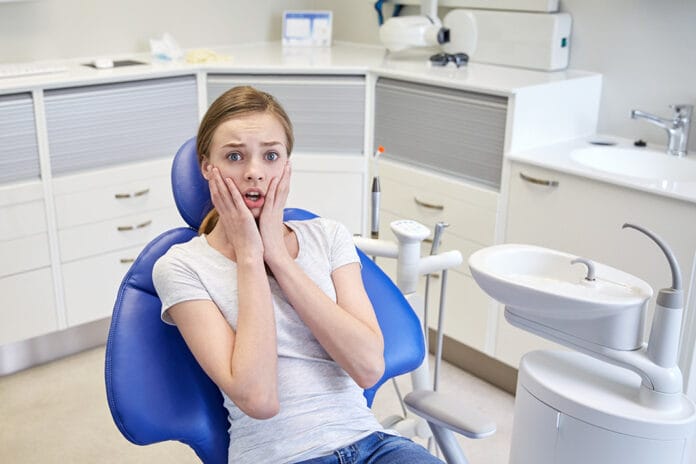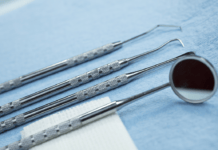Fear, anxiety, or phobia, tend to be used interchangeably when describing emotions about the dental office, and I’ll refer to these terms as a whole as being apprehensive. Fewer dental patients are enthused about visiting the dentist versus those who don’t. Dental apprehension can affect oral health by delaying or avoiding care, causing extensive or complex treatments, including oral cancer.
Patients who feel apprehensive about dentistry usually mention their negative experiences that happened when they were younger. Even though they have had multiple good experiences for years, that one bad occurrence lasts a lifetime. Bad dental experiences can be perceived as traumatic enough to have kept the patient away from the dental office for years.
The perceptions are different in everyone. What is considered dental trauma to one person means nothing to another patient.
When a traumatic event is described with emotion, it suggests the patient is reliving it to the point of apprehension. When they go into detail about how they felt from the bad experience, they seem to talk about it as if they’re in a therapy session. When the patient states the adverse events as a matter-of-fact, they have usually overcome them.
Memories are relived by the senses. A sound, a smell, or the sight of something can trigger an emotion and bring one right back to the trauma. A way to fix it is by changing the emotional contact to that memory. As people usually can’t control the sense around them, they can control the feeling behind the sense.
For example, we can’t stop all dental drills from running while an anxious person is in the office. But that person can change the emotion they associate with it. For example, if the drill sound generates anxiety due to a patient’s terrible experience, telling the patient the benefits of the drill could reduce anxiety. When the patient now hears the drill, it is a tool for the process of removing pain or infection of a tooth to bring the mouth to a healthier place.
The causes of apprehension in dentistry often are:1
- Trust, or fear of loss of control
- Claustrophobia or agoraphobias
- Traumatic dental or medical experience
- Abuse
- The invasion of personal space
- Previous trauma to the head or neck
The Many Faces of Fear
Fear is the distressing emotion of either a real or an imagined threat. It is aroused by impending danger, pain, or evil. It’s an unpleasantly strong emotion in the presence of danger.2 Dental fear is an abnormal emotional reaction to one or more perceived and specific life-threatening stimuli in a dental situation.
There is true fear or unwarranted fear. With true fear, cortisol, lactic acid, and adrenaline are released in connection to the fight-or-flight response. These responses accelerate breathing and heart rate, vasoconstrictions of the peripheral vessels leading to blood pooling and muscle tension, hyperglycemia, and alertness. True fear is a signal in the presence of danger based on perception and the environment of the circumstances.
Unwarranted fear is based on something that is imagined or in the memory.3 A dental appointment is unwarranted fear since it is not life-threatening, and the odds are they will walk out alive. Patients have had multiple good experiences and one or very few bad experiences in the dental office. The bad ones, though, aren’t only memories but debilitating for some.
People tend to fear being hurt, the unknown, or reliving a horrific experience. Fear-related dental pain can be very mild, with the perception of a regular, painless hygiene appointment as being excruciating. The unknown is more likely with children since adults have experienced many dental appointments and know the routine. When reliving a bad dental experience, the patient knows the worst-case scenario can happen.
Fear can be innate or learned. Dental fear would be learned since people are not born with a natural fear of dentistry. Learned fear is from experience or observing a traumatic accident. The brain doesn’t know where the fear originated, and it just reacts with fear, whether it’s learned or there was a direct experience.4
“Fear of the dentist” is a general term, and the reasons usually include the experience of pain, numbness, gagging, sounds, smells, and needles.
When Learned Fear Becomes the Enemy
Learned fear is what I witnessed with the mom who brought her eight-year-old son in for an emergency with great pain in a tooth. She never allowed radiographs on her or her family because they were destructive and life-threatening, in her opinion. A radiograph was needed in this situation.
The son cried, yelled, and physically refused the sensor to be placed in his mouth. He kept telling the mom that he was going to be harmed and even killed by the radiograph. The mom spent time trying to convince him it was OK this one time to have a picture taken. She even resorted to lying that it wasn’t a true radiograph but just a camera taking a photo, such as with a cell phone.
Fear isn’t the only adversity of negative dental experiences. A phobia or general anxiety are other hindrances.
Anxiety ‒ Dental anxiety can be experienced by 50% to 80 % of adults, with 20% of those who do not see a dentist regularly, and 9% to 15% avoid treatment completely. Dental anxiety is highly connected with missed appointments, avoidance of care, and more extensive treatment diagnosis.5
Anxiety is the distress or uneasiness of the mind caused by fear of danger or misfortune; a strong desire, nervousness, or uneasiness mixed with doubt or fear over an impending or anticipated concern.6 Dental anxiety is the state of apprehension that something dreadful will happen during dental treatment and is usually associated with loss of control or pain. Having dental anxiety is uncomfortable, but a patient can still tolerate dental procedures.
Existing mental conditions of post-traumatic stress disorders, generalized anxiety disorders, depression, bipolar disorders, and schizophrenia can be a precursor for dental anxiety. Some symptoms are sweating, fainting, racing heartbeat, silence or minimal interaction, irritability, humor, panic, distress, panicking, or crying.1
Dental anxiety commonly starts in childhood but can be overcome with positive future dental appointments. Adults who become anxious about dental care may carry it with them throughout life.1 Women experience more dental anxiety than men.5
Phobia ‒ More intense than anxiety, a phobia is an exaggerated fear that causes people to be terrified. It’s an intense, persistent, and irritational fear of a specific object, activity, situation, or person, leading to physical symptoms of sweating, trembling, rapid heartbeats, and shortness of breath.7 A phobia can cause the avoidance of situations and severe paralysis.
Phobias can be caused by traumatic experiences, substance abuse, or passed on from parents. People with dental phobias usually avoid the dentist and neglect oral health until they have a very painful problem and are driven by pain to see a dentist. Many times, this type of emergency treatment worsens the phobia. Patients with dental phobias are more likely to have one or more missing teeth or areas of decay, periodontal disease, and issues with eating, drinking, or talking.8
True phobic dental patients rarely get hygiene treatment. Their chart notes are littered with emergency appointments and maybe one or two visits with a hygienist. They may have multiple missed or rescheduled appointments.
Signs of dental phobia are when patients have trouble sleeping the night before an appointment. Anxiety increases while in the dental office, and they experience difficulty breathing, crying, or feeling physically ill. A simple dental appointment in a phobic’s mind is portrayed as the barbaric scene from the movie Marathon Man.
Some steps to helping an apprehensive patient include:
- Explain before and during the appointment what is happening so there are no surprises
- Bring headphones to block out dental noises or to listen to music, podcasts, or a book
- Have a picture on the ceiling for distraction
- Getting them back into the operatory as soon as possible as waiting can increase any apprehensions
- Using topical anesthetic and/or nitrous oxide
- Let the patient know they can stop or take a break at any time
- Remind the patient to breathe
- Suggest a weighted blanket or use of the lead apron
- Medications for sedation such as Halcion or Valium may be necessary
Other Emotional Descriptions
Worry ‒ Worry is a state of anxiety and uncertainty. When it occurs in the thoughts, worry is a realistic, specific concern.9 Patients sometimes will use worry to explain their emotions. They worry about the appointment as to what the dentist will find, that it may hurt, or about the cost of the appointment. They are usually specific with their concerns.
Nervous ‒ Nervous is being easily agitated or alarmed and a tendency toward anxiety, apprehension, and even highly strung.10 When patients state they are nervous about the appointment, sometimes it’s generalized about everything about to happen during treatment, or sometimes it’s a particular issue where a part of the mouth may feel pain.
Dislike of dentists ‒ This is different from the above issues. Patients in this category usually just don’t like the lectures, sounds, needles, someone so close to them, or working in their mouth. Going to the dentist isn’t debilitating or the worst thing, but there are other places they’d rather be. It’s like going to the DMV or grocery shopping; it’s not enjoyable, but they still go.
Calming Fearful Children
Experiencing something bad when young is different from experiencing something bad as an adult. It’s usually amplified as it can’t be rationalized or understood.
Dentistry is currently more comforting with anesthetics, nitrous, sedation, and better and faster radiographic technology. Children’s prophies are harmless, and radiographs should not be scary ‒ may be uncomfortable, but not scary.
I do not work in a pediatric office, so I don’t see children all day long. In my experience, children seem to be scared based on two matters ‒ the unknown and learned fear.
The unknown can bring anxiety to anyone receiving dental care. It’s usually about how the procedure is going to happen and the worry about feeling pain. It’s the anticipation of the worst. Children have not been able to finagle the world yet, so they pick up cues from their parents. The learned fear from a parent (honestly, I have seen it more often from mothers, not fathers) can unintentionally persuade the child to be anxious just by releasing negative energy. While some mothers unconsciously express their fear in front of the child, some are proactive in making the dental appointment as enjoyable as ever.
The child may show his fear through crying, screaming, shivering, panicking, worrying, being fidgety, and refusing to sit in the chair or open their mouth ‒ uncooperative overall. Some ways to promote a positive dental experience in children and prevent future anxiety or fear are:
- To encourage the parent to bring the child to the parent’s or a sibling’s dental appointment
- Do a tour of the dental office
- Prepare the child for the dental appointment by explaining what will happen as well as the routine of an appointment
- Encourage the parent to be positive when talking about dentistry (Don’t say, “This won’t hurt” because then the child will there’s a chance it will hurt)
- Have the child bring something familiar to them to their appointment for comfort
- Make the dental appointment a special time or day and reward good behavior
- If the child isn’t in the mood that day, don’t force it
A Focus on the Safe Environment
Dentistry is safe. It’s not a place where patients worry about their life. In the end, they know they will walk out of the office and go on with their day. People do reckless/adventurous things that put lives in danger, such as driving erratically, downhill skiing, sky diving, scuba diving, rock climbing, riding roller coasters, or doing drugs and drinking excessively. They aren’t scared enough to avoid life-risking activities. While dentistry is safe, people avoid it because they don’t like it or had an unpleasant experience years ago.
Dentistry has come a long way with many improvements in comfort, techniques, and knowledge. This generation of dentistry is not causing fear in people as suffered with prior generations. Years ago, fear came when the customary practice was no anesthesia, as well as when teeth were extracted or not saved. During that era, complaining was strongly discouraged, and the patient just laid there and stayed quiet.
I’ve noticed how most fearful patients are middle-aged. The older generation, who apparently lived in a generation where dentistry was more archaic, seem to deal with dentistry better ‒ whether it’s better coping skills or taught not to complain or express their fears. Or they may know the reality that dentistry has improved compared to older dental treatments. The younger generation only knows of improved and comfortable dentistry since they were children. There are not many millennials and younger patients with dental phobias or fears from actual dentistry itself. But, on this note, this younger generation, in general, has higher cases of anxiety and depression that can convert into dental apprehension.11
When a patient states any kind of negative emotion toward the dentist, the dental office, or a procedure, it can be their cry for help in getting through their procedure. Put the patient at ease by pinpointing what is making them apprehensive(What’s the trigger?). Ask the patient what will help make the appointment as comfortable as possible and acknowledge to the patient that the cause of apprehension will not happen and/or what can be done to help. For example, if a patient’s horrific experience was root canal therapy and they never felt profound anesthesia, reassure them the procedure will not happen until they are fully anesthetized.
Again, advise apprehensive patients to wear noise-canceling headphones for any sound triggers. Limit the waiting time in the reception room since apprehension can exponentially increase as they wait. Have a poster on the ceiling on which they can focus.
Explain the procedure beforehand, and as you go so, the patient knows what to expect. Some patients want a detailed step-by-step itinerary, and some want a generalized itinerary. Either way, identifying the patient’s concerns to make the appointment comfortable and stress-free helps the patient during present treatment and when returning for future appointments.
Now Check Out the Peer-Reviewed, Self-Study CE Courses from Today’s RDH!
Listen to the Today’s RDH Dental Hygiene Podcast Below:
References
- Dental Anxiety and Phobia. (n.d.). Better Health Channel. https://www.betterhealth.vic.gov.au/health/conditionsandtreatments/dental-anxiety-and-phobia#who-can-be-affected-by-dental-anxiety
- Fear. (n.d.). Merriam Webster. https://www.merriam-webster.com/dictionary/fear
- Distinguish Between Fear and Worry. (n.d.). GDBA: Gavin de Becker and Associates. https://gdba.com/distinguish-between-fear-and-worry/
- Olsson, A., Nearing, K.I., Phelps, E.I. Learning Fears by Observing Others: The Neural Systems of Social Fear Transmission. Social Cognitive and Affective Neuroscience. 2007; 2(1): 3-11. https://www.ncbi.nlm.nih.gov/pmc/articles/PMC2555428/
- White, A.M., Giblin, L., Boyd, L.D. The prevalence of Dental Anxiety in Dental Practice Settings. Journal of Dental Hygiene. 2017; 91(1): 30-34. https://jdh.adha.org/content/91/1/30
- Anxiety. (n.d.). Dictionary.com. https://www.dictionary.com/browse/anxiety
- Phobia. (n.d.). Dictionary.com. https://www.dictionary.com/browse/phobia
- Dental Phobia Damages More Than Teeth. (2017, July 21). UK Dentistry. https://dentistry.uky.edu/patient-care/dental-phobia
- Worry. (n.d.). Dictionary.com. https://www.dictionary.com/browse/worry
- Nervous. (n.d.). Dictionary.com. https://www.dictionary.com/browse/nervous
- Soelro, L. (2019, July 24). Why are Millennials So Anxious and Unhappy? Psychology Today. https://www.psychologytoday.com/us/blog/i-hear-you/201907/why-are-millennials-so-anxious-and-unhappy












